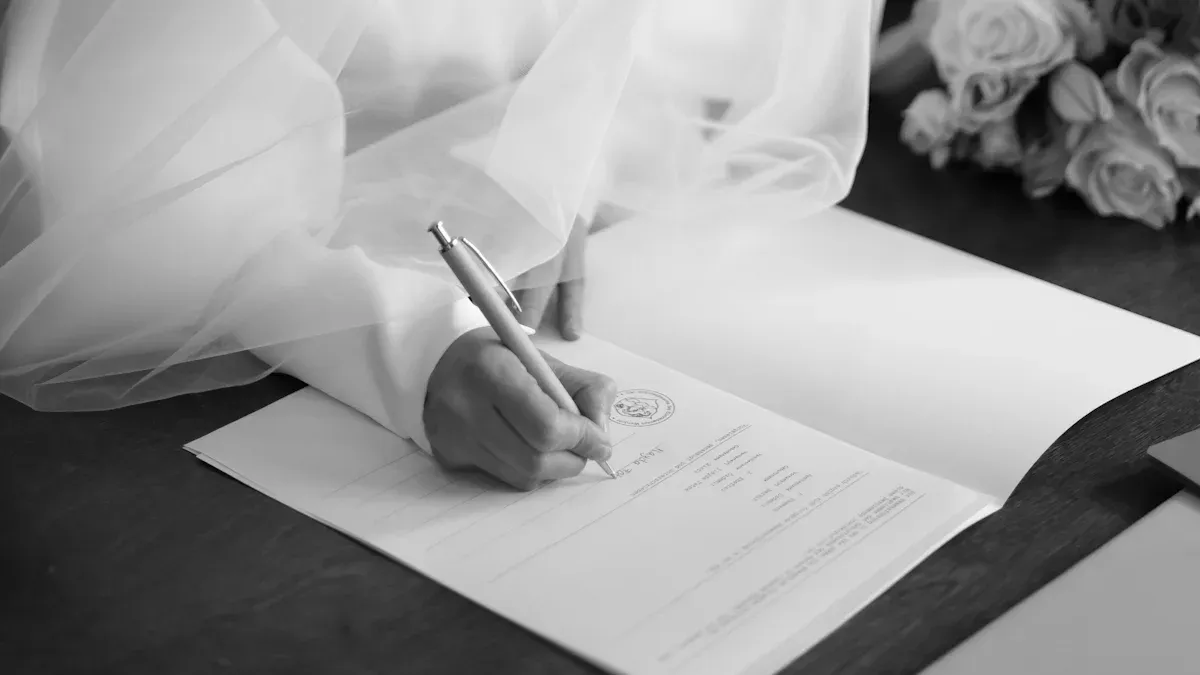Everything You Need to Know About the 60-Day Waiting Period for Divorce in Texas

When you file for divorce in Texas, the law requires you to wait 60 days before the court can finalize your case. The waiting period starts the day you file for divorce, not when you separate. Even if both sides agree, every divorce Texas case must follow this rule. You cannot skip the waiting period unless the court grants an exception. Many people also ask about the cost to file for divorce or how the process works. If you plan on filing for divorce, you need to understand these steps.
Waiting Period for Divorce in Texas

When the 60 Days Start
The waiting period for divorce in Texas starts when you file your divorce petition. This is the official start of your case. Texas law says the court cannot grant a divorce until 60 days have passed. This rule is for every divorce Texas case, even if you and your spouse agree on everything. After you file, you must make sure your spouse gets legal notice. The 60-day countdown starts right after you file, not when you separate or get your paperwork ready.
Tip: Filing for divorce begins the countdown. Write down your filing date so you know when the waiting period ends.
What Counts Toward the 60 Days
The waiting period for divorce Texas cases counts every calendar day. You count weekends and holidays too, not just business days. The count starts the day after you file your petition. If the 60th day is on a weekend or holiday, the deadline moves to the next business day. For example, if you file on March 1, you start counting from March 2. If your 60th day is a Saturday, you can finish your divorce on Monday.
Here is an easy way to track your waiting period:
Step | What to Do |
|---|---|
Write down the filing date | |
Start counting from next day | Count weekends and holidays |
Check the 60th day | If weekend/holiday, go to next weekday |
Why the Waiting Period Exists
The waiting period for divorce gives you and your spouse time to think about your choice. Texas lawmakers made this rule so couples do not rush into ending their marriage. The waiting period is a "cooling off" time. It lets both sides think about their choices and maybe fix problems. Even if you both agree, the court cannot finish your case before the 60th day unless there is an exception, like family violence.
Note: The waiting period for divorce is not just a rule. It gives you time to get ready, collect papers, and plan for life after divorce.
You must follow the waiting period in almost every divorce Texas case. There are only a few exceptions, and the court takes these seriously. Knowing this rule helps you plan what to do after you file for divorce.
Divorce Texas Process Timeline

Filing the Petition
You start the divorce process in Texas by filing for divorce at the courthouse in your county. Before you file for divorce, you must meet residency rules. You or your spouse must have lived in Texas for at least six months and in your county for at least 90 days. Here is a simple list of what you need to do:
Make sure you meet the residency requirements.
Prepare the Original Petition for Divorce. This document starts your case.
Complete a Civil Case Information Sheet if your county requires it.
Decide if you want to file in person at the courthouse or online using eFileTexas.gov.
Pay the filing fee, or ask for a fee waiver if you cannot afford it.
Attach any temporary orders or protective orders if needed.
Tip: Filing for divorce begins the official process. Keep copies of all documents for your records.
The 60-Day Waiting Period Step
After you file for divorce, the 60-day waiting period begins. This step is required in almost every divorce texas case. The court cannot finalize your divorce until this period ends. You count every day, including weekends and holidays. Use this time to gather important documents, talk with your spouse about agreements, and prepare for the next steps.
Step | What Happens |
|---|---|
File for divorce | Start the 60-day waiting period |
Wait 60 days | Prepare documents and negotiate |
After 60 days | Court can finalize the divorce |
What Happens If No Response
If your spouse does not respond after being served with the divorce papers, you can still move forward. The law gives your spouse until 10:00 a.m. on the Monday after 20 days from the date they receive the petition to file an answer. If they do not answer, you may ask the court for a default judgment. The court will review your requests and the evidence you provide. The judge will make sure your property division is fair and that any children’s needs are met. Default divorces are common when a spouse does not respond. The court cannot grant a default divorce until the 60-day waiting period ends.
Note: If your spouse misses the deadline but shows good cause, the court may still accept a late answer if the case is not finished.
Exceptions to the Waiting Period
Family Violence Cases
Texas law is strict about family violence. If you are in danger, you might not need to wait 60 days for your divorce. The court can let you skip or shorten the waiting period. This rule is there to keep you and your family safe.
Family violence means different kinds of abuse or threats. You could get an exception if you have:
Physical abuse or threats between people in a family or home
Violence or threats in a dating relationship
Abuse between spouses, ex-spouses, or parents of the same child
Harm or threats between foster parents and children
Sexual abuse, stalking, or drug harm to children
You can also ask the court to skip the wait if:
Your spouse was found guilty of family violence against you or someone in your home
There is a protective order or magistrate’s order for family violence during your marriage
Note: Courts do not give these exceptions a lot. Judges look at each case one by one. Talk to a lawyer if you think you might get an exception.
Other Legal Exceptions
Texas courts almost never make other exceptions to the 60-day waiting period. The law does not list other reasons to skip the wait. Judges can only let you skip the wait if your case has family violence or a related protective order.
Tip: If you do not have family violence, you will probably wait the full 60 days. Use this time to get your papers ready and plan what to do next.
Texas courts want you to be safe. If you need help, talk to a lawyer or local support groups right away.
What to Do During the Waiting Period
Negotiating Terms
You can use the waiting period to talk with your spouse about important issues. Many couples find this is a good time to discuss property, money, and plans for children. If you both agree on these topics, your divorce can move faster after the waiting period ends. You may want to try mediation. Mediation helps you and your spouse reach fair agreements without going to court. This step can save time and lower stress. When you file for divorce, you do not have to fight over every detail. You can work together to find solutions that fit your family.
Tip: Open and honest talks now can help you avoid problems later.
Preparing Documents
Getting your paperwork ready is a key step during the waiting period. You need to collect records about your home, bank accounts, debts, and anything else you own together. Make a list of what you and your spouse have. This list will help the court divide things fairly. You should also gather information about your children, like school records and health care details. If you have questions about the cost to file for divorce, check with your county clerk or ask your lawyer. Good records make the process smoother when the court reviews your case.
Document Type | Why You Need It |
|---|---|
Property records | To show what you own |
Bank statements | To track money and debts |
Child information | To help with custody decisions |
Working with Legal Help
A Texas family law attorney can guide you through each step. Lawyers help you prepare and review legal documents, such as divorce decrees and child custody orders. They can also help you negotiate fair settlements and avoid mistakes that might cause problems later. When you file for divorce, an attorney can explain your rights and answer your questions. Here are some ways a lawyer can help:
Gather important information and prepare paperwork
Help you talk with your spouse about property and children
Give advice so you do not make quick decisions you might regret
Offer support during emotional times
Make sure the court process goes smoothly
You can also use this time to think about your future. The waiting period gives you space to reflect on your choices and plan your next steps. If you need help, a lawyer can protect your interests and help you get the best outcome.
After the Texas Divorce Waiting Period
Finalizing the Divorce
When the 60-day waiting period is over, you can finish your divorce in Texas. There are a few steps you must do before the court ends your marriage:
Set up a hearing with the court. Each county has its own way to schedule, so ask your courthouse.
Go to the hearing. The judge will look at what you and your spouse want and any deals you made.
Show proof and tell your side. If you both agree, you might only need a "prove-up" hearing or send in a prove-up affidavit if allowed.
Wait for the judge to sign the divorce decree. This paper makes your divorce final.
Tip: If you and your spouse agree, you might finish soon after the waiting period. If you do not agree, it can take much longer, sometimes six months to a year or more, because of arguments or busy courts.
Remarriage Waiting Period
After your divorce is final, Texas law says you must wait before you can marry again. You have to wait 30 days from when the judge signs your divorce decree. This rule gives time for anyone to appeal or change the order. The 30 days start when the judge signs the decree.
Aspect | Details |
|---|---|
Waiting Period | |
Purpose | Time for appeals or changes |
Start Date | Date judge signs the decree |
Exceptions | Judge may skip for things like military duty or serious sickness |
Consequences | Marrying too early can make the new marriage not count |
Marriage License | You also must wait 72 hours after getting a license before the wedding |
A judge can skip the 30-day wait in special cases, like if someone is in the military or very sick.
If you marry before the wait is over and do not have a waiver, your new marriage might not count.
Always get a real marriage license and follow the 72-hour wait before your wedding.
Note: Doing these steps helps you stay out of trouble and makes sure your new marriage is legal.
Knowing about the 60-day waiting period in Texas divorce cases helps you get ready for what comes next.
You can use this time to talk with your spouse, collect important papers, and avoid mistakes like hiding things or not talking enough.
A Texas family law attorney can help you understand your rights and make things less stressful or slow.
If you need legal help, you can reach out to a local attorney or look for free help online. Doing these things can make your divorce go more smoothly.
FAQ
How soon can you file for divorce in Texas?
You can file for divorce after you or your spouse have lived in Texas for at least six months and in your county for at least 90 days. You must meet both rules before you file.
Can you speed up the 60-day waiting period?
You cannot speed up the waiting period unless your case involves family violence or a protective order. Most people must wait the full 60 days before the court can finalize the divorce.
What happens if you reconcile during the waiting period?
If you and your spouse decide to stay married, you can ask the court to dismiss your divorce case. The court will close your case, and your marriage will continue.
Do you need to go to court after the waiting period ends?
Most cases require at least one court appearance. You or your lawyer will present your agreement or evidence. Some counties allow you to submit paperwork without a hearing if both sides agree.
See Also
Understanding The Sixty Day Divorce Waiting Rule In Texas
Reasons Behind Texas Sixty Day Divorce Waiting Requirement
Six Important Divorce Laws Every Texan Should Understand
Subscribe to get the updates!
Sign up now to receive timely blog updates.
I accept the email subscription terms.

